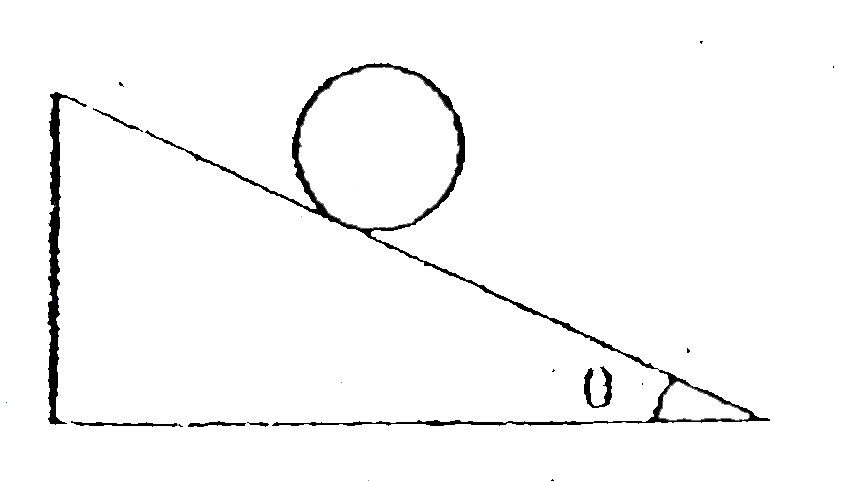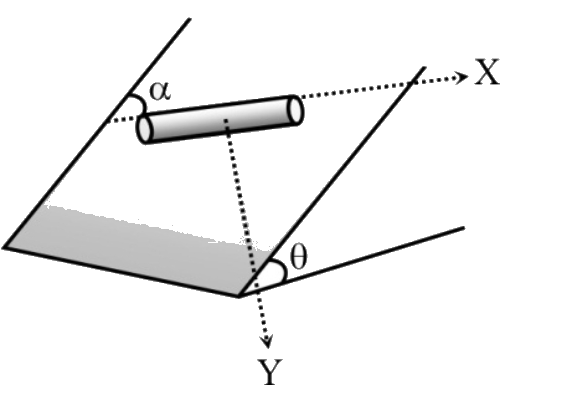An inclined plane makes an angle of with horizontal. A disc rolling down this inclined plane without slipping has a linear acceleration equal to
The correct Answer is:C
To find the linear acceleration of a disc rolling down an inclined plane at an angle of 60∘ with the horizontal, we can follow these steps:
Step 1: Identify the formula for linear acceleration of a rolling body
The linear acceleration a of a rolling body can be calculated using the formula:
a=gsinθ1+k2r2
where:
- g is the acceleration due to gravity,
- θ is the angle of inclination,
- k is the radius of gyration,
- r is the radius of the disc.
Step 2: Calculate the radius of gyration for a disc
The radius of gyration k is given by:
k=√Im
For a disc, the moment of inertia I is:
I=12mr2
Substituting this into the formula for k:
k=√12mr2m=√12r2=r√2
Step 3: Substitute k into the acceleration formula
Now, substituting k=r√2 into the acceleration formula:
a=gsinθ1+(r√2)2r2=gsinθ1+r2/2r2=gsinθ1+12=gsinθ32=2gsinθ3
Step 4: Calculate sin60∘
We know that:
sin60∘=√32
Step 5: Substitute sin60∘ into the acceleration formula
Now substituting sin60∘ into the equation for a:
a=2g⋅√323=g√33
Step 6: Final result
Thus, the linear acceleration of the disc rolling down the inclined plane is:
a=g√33
Step 7: Simplify the expression
This can also be expressed as:
a=g√3
Conclusion
The final answer is:
The linear acceleration of the disc is g√3.
---
The linear acceleration a of a rolling body can be calculated using the formula:
a=gsinθ1+k2r2
where:
- g is the acceleration due to gravity,
- θ is the angle of inclination,
- k is the radius of gyration,
- r is the radius of the disc.
The radius of gyration k is given by:
k=√Im
For a disc, the moment of inertia I is:
I=12mr2
Substituting this into the formula for k:
k=√12mr2m=√12r2=r√2
Now, substituting k=r√2 into the acceleration formula:
a=gsinθ1+(r√2)2r2=gsinθ1+r2/2r2=gsinθ1+12=gsinθ32=2gsinθ3
We know that:
sin60∘=√32
Now substituting sin60∘ into the equation for a:
a=2g⋅√323=g√33
Thus, the linear acceleration of the disc rolling down the inclined plane is:
a=g√33
This can also be expressed as:
a=g√3
The final answer is:
The linear acceleration of the disc is g√3.
Topper's Solved these Questions
- BOOK - DC PANDEY ENGLISHCHAPTER - ROTATIONAL MOTIONEXERCISE - A Only One Option is Correct86videos
ROTATIONAL MOTION
- BOOK - DC PANDEY ENGLISHCHAPTER - ROTATIONAL MOTIONEXERCISE - More than one option is correct36videos
ROTATIONAL MOTION
- BOOK - DC PANDEY ENGLISHCHAPTER - ROTATIONAL MECHANICSEXERCISE - Subjective Questions2videos
ROTATIONAL MECHANICS
- BOOK - DC PANDEY ENGLISHCHAPTER - SEMICONDUCTORS AND ELECTRONIC DEVICESEXERCISE - More than One Option is Correct3videos
SEMICONDUCTORS AND ELECTRONIC DEVICES
Similar Questions
An inclined plane makes an angle 30° with the horizontal. A solid sphere rolling down this inclined plane from rest without slipping has a linear acceleration equal to
View SolutionA solid cylinder is rolling down the inclined plane without slipping. Which of the following is correct?
 View Solution
View SolutionA cylinder is rolling down on a inclined plane of inclination60∘. What is iths acceleration?
View SolutionA block is at rest on an inclined plane making an angle α with the horizontal. As the angle of the incline is increased the block start slipping when the angle of inclination becomes θ then coefficient of friction is equal to
View SolutionA disc of radius R is rolling down an inclined plane whose angle of inclination is θ Its acceleration would be
View SolutionA cylinder of mass m is kept on an inclined plane haivng an angle of inclination 30∘. Axis of the cylinder makes an angle 30∘ with the line along the greatest slope. Assuming that cylinder rolls without slipping, the acceleration of the cylinder is
 View Solution
View SolutionA block placed on an inclined plane making an angle 17∘ with the horizontal slides down without any acceleration. What is the acceleration of the block if the inclimation is increased to 30∘ ?
View SolutionA cylinder rolls down an inclined plane of inclination 30∘, the acceleration of cylinder is
View SolutionA block slides down an inclined plane that makes an angle θ with the horizontal. If the coefficient of kinetic friction is μ, find the acceleration of the block.
View SolutionA body is rolling down an inclined plane. Its acceleration will not depend on the following:
View Solution

